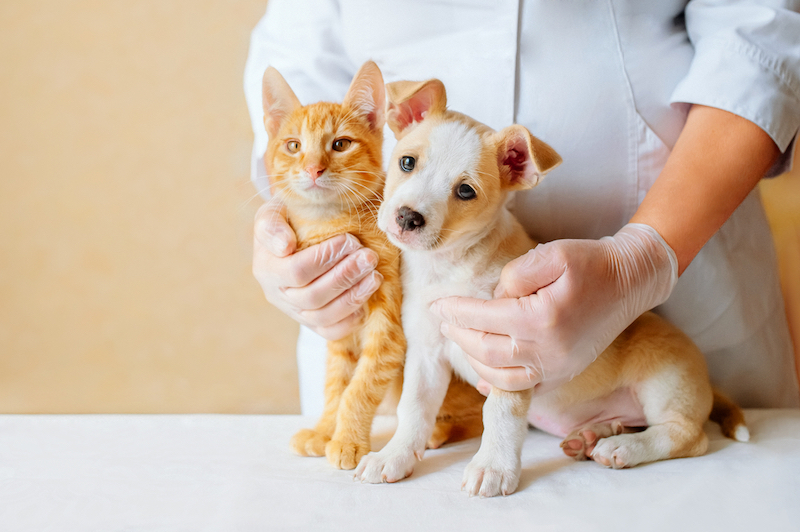Pet Insurance 101: What is Pet Insurance & Why You Need It

If you have a pet, then you already know that they’re not just an animal: They’re family. That means that when your pet is hurt or sick, you want to be able to do everything in your power to get them better.
Unfortunately, visits to the vet can be quite expensive, especially when they are the result of unplanned emergencies. Depending on the specific reason you are bringing them to the vet, getting your pet care can cost anywhere from hundreds to thousands of dollars — a reality that only makes an already hard time even harder.
The good news is that there’s a tool you can use to help lower the cost of both planned and unplanned vet visits: Pet insurance.
Below, we take a look at what pet insurance is, how it works, what it does and doesn’t cover, and the factors that may influence the costs of a policy. We also discuss who needs pet insurance and outline steps for purchasing coverage.
What is pet insurance?
Pet insurance is essentially a form of health insurance that you can buy for your pets to help lessen the cost of various types of veterinary care. It reimburses you for some or all of the cost that you pay for your pet’s medical expenses.
Pet insurance can prove particularly valuable for covering surprise injuries and illnesses, which may include a number of diagnostic tests and procedures to treat, each of which carry their own costs.
Despite the value offered by pet insurance, the vast majority of pets are currently uninsured. According to a 2022 report by the North American Pet Health Insurance Association (NAPHIA), approximately 90.5 million North American families — that’s about 70% — own at least one pet. Of the total 175 million pets owned in North America, only 4.4 million are currently insured.
How does pet insurance work?
Applying for pet insurance
In order to cover your pet, you’ll first need to purchase a pet insurance policy from a carrier that offers it.
This policy will outline key information about your pet’s coverage, including the types of injury, illness, and care that are eligible for coverage — and, importantly, those which are not. The policy will also outline your deductible (how much you must pay out of pocket before coverage kicks in), your reimbursement level (how costs will be split between you and the insurer once your deductible has been met), and the annual maximum (the maximum amount that the policy will cover in any given year).
The first step in applying for coverage is typically to complete a form that provides key information about your pet, such as their species, breed, age, and general health. Following this initial screening, most pet insurance carriers will require a health checkup on your pet. This is to identify what, if any, pre-existing conditions your pet may have, as these are typically not covered by pet insurance.
After the health check, most carriers will impose a waiting period before coverage officially kicks in. This waiting period can last anywhere from a few days to a few weeks, depending on the carrier and type of coverage you purchase.
You’ll then maintain coverage by paying a monthly premium, much like you would for homeowners insurance or auto insurance.
Submitting a pet insurance claim
Once your pet insurance policy kicks in, leveraging its benefits will generally look like this:
- In the event that your pet is injured or becomes ill, just bring them to the vet for care as you normally would. You don’t need to worry about whether or not your vet is in or out of network; with pet insurance, there are no networks, so you can rest easy knowing that you’re covered.
- Following your pet’s visit, you’ll pay out of pocket as normal. You will then submit a claim to your carrier.
- The carrier will review your claim and determine whether or not the services your pet received are covered under the policy.
- If they are covered, the carrier will then check to see if you have met your deductible. If you haven’t met the deductible, then you’ll have to pay for the services out of pocket until the deductible has been met; if you have met the deductible, then the carrier will process a reimbursal.
- What percentage of the vet bill is reimbursed will depend on your reimbursal level. Most pet insurance policies cover between 50% and 100% of covered services, once the deductible has been met. Check your policy if you are unsure about your reimbursal level.
- Depending on the carrier, you may receive your reimbursal by direct deposit or physical check, typically within a few days to a week after your claim has been approved.
What does pet insurance cover?
Exactly what is covered by your pet insurance policy will depend on the level of coverage provided by the terms of the policy. That being said, pet insurance can cover some range of the following categories of veterinary care:
- Accidents and injuries, such as broken or dislocated bones, cuts, swallowed objects.
- Illnesses, such as infections, parasites, lyme disease, parvo, diabetes, cancer.
- Hereditary and congenital conditions, such as hip dysplasia, allergies, epilepsy, glaucoma.
- Dental accidents and illnesses, such as root canals, gingivitis, etc.
- Routine care, such as annual checkups, vaccinations, and other preventative care.
- Laboratory testing, such as bloodwork and diagnostic imaging such as X-rays, MRIs, and ultrasounds.
While the above components are commonly included in pet insurance policies, individual carriers may or may not offer each of them. As a general note, the more types of coverage your policy offers, the more expensive it will typically be.
Depending on the carrier, it may be possible to buy a more limited policy, or a comprehensive policy that offers even more coverage. Pet insurance carriers will commonly offer coverage in the following tiers:
- Accident only: This is typically the lowest (and least expensive) level of coverage.
- Accident and illness: Accident and illness builds upon accident coverage.
- Comprehensive coverage: This level builds upon accident and illness coverage, typically by broadening coverage for genetic and hereditary conditions.
- Wellness: Many carriers offer a wellness “add-on” which broadens coverage to include routine care.
What’s not covered by pet insurance?
While it is possible to purchase comprehensive pet insurance policies that provide considerable coverage, most will include at least some exceptions for services which will not be covered.
For example, virtually no pet insurance policy will cover pre-existing conditions — injuries or illnesses that your pet already had prior to coverage beginning. Likewise, your policy typically won’t cover non-vet related expenses such as:
- Cosmetic procedures
- Grooming
- Training
- Behavioral issues
Additionally, some forms of veterinary care that are often covered by pet insurance may also be excluded, depending on your carrier and policy. Dental care, hereditary conditions, and routine care, while often covered, are also commonly listed as exclusions.
Because of this, it’s incredibly important that you understand what, if any, exceptions your policy may include, as well as your pet’s unique risk for them, before opting into any plan.
How much does pet insurance cost?
How much you’ll pay for a pet insurance policy will depend on a number of different factors, each of which will impact your premiums. These include your pet’s:
- Age: The younger your pet is, the less expensive premiums are likely to be. This is due to the fact that the cost of veterinary care typically increases as your pet gets older.
- Gender: Because male pets are statistically more likely to have claims filed on their behalf than female pets, they tend to cost more to insure.
- Species: Some species of animal cost more to insure than others. Generally speaking, dogs, for example, cost more to insure than cats.
- Breed: Because certain breeds are predisposed to particular injuries and illness, your pet’s breed may impact your premiums.
- Location: Where you live may have some impact on your pet insurance premiums. Many times, it costs more to insure a pet in a city than in the suburbs, due to the increased likelihood of injury.
With this in mind, according to NAPHIA, the average cost to insure a dog in the United States was $583 per year in 2021, or approximately $49 per month. Meanwhile, the average cost to insure a cat was $342 per year or $28 per month.
The bottom line on pet insurance
If you’re a pet parent, then you know how expensive a surprise visit to the vet can be. Pet insurance offers you valuable peace of mind to know that if your pet ever becomes injured or ill, you can get them the care they need without breaking the bank.
At Matic, we believe that finding the right policy for your pet shouldn’t be complicated. That’s why we’ve partnered with Embrace Pet Insurance to offer our customers comprehensive pet insurance policies that cover virtually everything other than pre-existing conditions — even those things typically excluded by other carriers. And with policies starting at just $1 per day, there’s bound to be coverage that fits within your budget.


